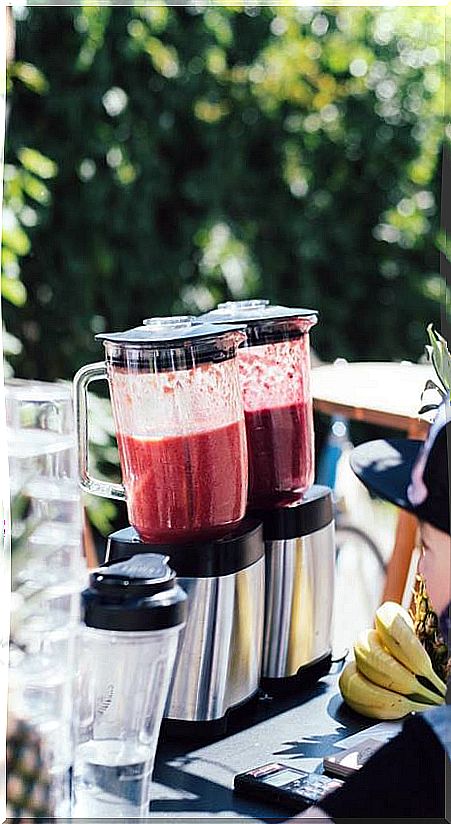7 Reasons To Prepare Your Own Natural Juices
In summer, the abundance of fruits and vegetables invites you to prepare tasty and nutritious juices and smoothies that provide water, vitamins, minerals, fiber and a large amount of antioxidants.

Summer is coming, and with it heat and thirst. We move more, do more outdoor activities, perspire easily, and need to rehydrate often. In addition to drinking water, it can be used to drink beverages that, while quenching thirst, balance health and vitality. It is the ideal time to immerse yourself in the world of juices and smoothies.
In summer, the markets see a festive explosion of seasonal fruits and vegetables of all shapes, sizes and colors. In them you will find all the vitality of the plant in its moment of maximum splendor. When taken raw, those nutrients that fill them with flavor are kept. Making these foods tasty, healthy and refreshing juices and smoothies is a joy.
It is about true gastronomy, for the pleasure of the flavors that can be obtained by combining vegetables in the most varied and surprising recipes. But with the difference that the preparation time and difficulty are minimal. If you have a centrifugal blender or a blender, it will be enough in most cases to clean the ingredients well, cut them and place them in the container to extract their juice or blend them for a few seconds.
7 benefits of drinking juices and smoothies in summer
There are other reasons to give space in the usual diet to this type of preparation. In addition to their organoleptic quality, plant drinks nourish and are an excellent preventive and health regulator. They are a delicious way to enhance any diet, adding the portions of fresh fruit and vegetables that are often lacking. For something, it is recommended to take five daily servings of raw vegetables!
- Due to its high percentage of water, which purifies the body and restores the liter and a half of liquid that is lost throughout the day. As it is loaded with minerals and vitamins, its effect is isotonic and is perfectly assimilated.
- For its very important contribution of micronutrients and trace elements : flavonoids, polyphenols and organic acids such as malic or citric. They are the stars of recent nutritional research for their great antioxidant and preventive power of nervous disorders and degenerative or aging diseases. Brightly colored fruits and vegetables such as beets, berries, and tomatoes are the highest in flavonoids.
- Due to its large amount of minerals and vitamins, essential for all kinds of metabolic functions. Fruits and vegetables are especially rich in carotenes, precursors of vitamin A, as well as vitamin C, potassium and phosphorus.
- Due to the presence of fiber, which facilitates intestinal transit and regenerates its flora, preventing all kinds of disorders derived from constipation.
- Because they help maintain the alkaline balance of the blood and help clean arteries that are clogged with saturated fats.
- Because they are living foods that preserve their enzymes. They join with those of our intestinal flora and favor the absorption of the nutrients in the juice and its rapid distribution throughout the body. Enzymes metabolize food into energy, help maintain the body’s hormonal balance, stimulate the immune system, and are vital to the functioning of the brain and nervous system.
- Because, when it comes to leafy vegetables, they provide chlorophyll, which contains magnesium. This mineral is a constituent of bones and teeth that intervenes in the acid-base balance and in the nervous, muscular and enzymatic activities.
All these elements are present in each of the fruits and vegetables, and it is their combined effect that is especially beneficial. Thus, even if a commercial juice is enriched with synthetic vitamin C, it will never be able to balance the rest of the micronutrients that accompany the raw material in its original organic form.
How to prepare juices and smoothies in a few minutes
- Citrus juices. A juicer is usually used, manual or electric. In general, they filter the fiber well, so the juice is liquid and clear. You have to drink it as soon as possible, if possible in the next 15 minutes, so that you do not lose your vitamins.
- Fruit or vegetable juices. The ideal device is a centrifugal blender, which sets aside the pulp and fiber. The ingredients are introduced with the skin well washed. The result is sparkling juices that are very suitable for combinations of all kinds. They are easily digested but lack some of their nutrients. They rust quickly, so you have to take them fresh.
- Fruit smoothies. They are mixtures that are prepared in a glass blender or food processor. In addition to the juice, the pulp and fiber are used, so waste is minimal. They are creamy and very nutritious because they contain all the vitamins, minerals and trace elements of fruit and vegetables. They are kept cold for a few hours. It is the most suitable method for bananas and berries.
- Slushies. They are fruit or vegetable juices mixed with crushed ice. They are made with a kitchen robot that can perform this function, pouring the fruits and ice into the glass. A large amount of juice is extracted because it pulverizes the fruits at great power. All its properties are used, which are preserved by the cold.
Suitable for everyone
Although juices and smoothies should not be understood as a panacea, they do positively affect our health, vitality and appearance. Sprouted seed juices are the most suitable as cleansers and antioxidants. If the wheat or barley sprouts are allowed to grow a little , they can be blended with a special juice extractor. It also works for alfalfa leaves.
As they are digested quickly and without overloading the digestive system, the juices are easy to assimilate and allow you to eat more fruit and vegetables than if they were taken in pieces.
On the other hand, although the fructose in fruits does not need insulin to be metabolized, people with diabetes should drink these drinks accompanied by whole grains, such as toast, or make cocktails, preferably vegetables, to slowly carry out the metabolism of the glucose.
In the same way, those who suffer from candidiasis should preferably choose vegetables or less sweet fruits to make their recipes.
What juices and smoothies to drink according to the time
There are juices for any time of the day. They can be taken for breakfast, as a snack or as a healthy snack while waiting for lunch and dinner. They are ideal for the diet of children and, being so digestive and light, they are very suitable for the convalescent and the elderly.
- Energetic. To wake up after an overnight fast and prepare for the day. It is surprising how powerful a sense of vitality they provide during a remarkable part of the morning. Fruits are recommended, especially citrus fruits. They are a good option to stay alert during class or work hours, because their regular consumption improves the efficiency of the mind.
- Restorative. To revitalize yourself in the middle of the morning, instead of coffee or chocolate, you can take a juice to work or class, kept in a cold thermos. A good option is to prepare it with raspberry, melon, pineapple and banana. The most suitable vegetables are carrots and beets.
- Invigorating. After a long day, to recover from fatigue it is best to prepare a juice with green leafy vegetables such as spinach, broccoli or watercress. If you notice that the sugar levels have dropped with the wear and tear of the day, you can use fruits such as raspberry, peach, kiwi or strawberry. Another option is to make a cocktail with carrot, apple and mint leaves to savor the freshness in your mouth.
- Relaxing To prepare for rest you can use lettuce leaves, which help calm the nervous system and relax before sleeping. Due to their richness in antioxidants, iron and B vitamins, they are an excellent way to neutralize stress. They can be combined with carrot and banana, rich in the amino acid tryptophan, which also helps you sleep.
- Purifying. To help flush out stored toxins, lose a few pounds, and combat laziness and discomfort. The juices can be diluted with water if you want them to be more hydrating. Among the best ingredients to prepare these juices are celery, parsley, mint, rosemary, ginger, oregano, cucumber, leeks and apples.
Homemade or packaged?
Smoothies and natural juices are especially suitable to replace snacks or industrial pastries, since instead of providing calories without nutrients, they provide more nutrients for each calorie. Homemade or quality beverages, these beverages significantly improve the dietary profile of commercial carbonated soft drinks, such as lemonades, colas, sports or energy drinks, and cold teas.
The wide acceptance of these drinks with little or no nutritional value is surprising, with added sugar or sweeteners, carbonic and phosphoric acids, numerous additives (flavor enhancers, colorants, flavorings, stabilizers or preservatives) and in some cases caffeine.
Its pH is also very acidic for the body. Something similar happens with packaged juices. Many families include them in their diet believing that they are equivalent to eating fresh fruits. It is not like this. It should be noted that most are made from concentrates that are obtained after subjecting the juice to a heat evaporation treatment that destroys enzymes, organic acids and many vitamins. The concentrates are packed with different proportions of water, and usually sugars, aromas and preservatives, in addition to some synthetic vitamins such as C. The best contain up to 20% concentrate and the rest water.
It is important to pay close attention to what the labels say. Fruit nectar usually has 10% concentrate, 85% water and 5% sugars and additives, while the fruit drink only contains 3% concentrate, 87% water and up to 10% % sugar and additives.
It is also the composition of non-carbonated soft drinks. Due to their high sugar content, they present the same risk problems for diabetes, obesity and tooth decay as soft drinks, and their dietary intake is still very low. Special mention should be made of those made with 100% fruit juice. Many are prepared with fruit of organic origin and do not contain added water, sugar or any type of additive.
They are, by far, the most recommended and healthy, indicated when it is not possible to make a natural juice. But for their conservation they must be pasteurized, which means raising their temperature to 72 ºC for a few seconds before being vacuum packed. Various brands of organic juices use this system, which maintains many of its properties. However, some of the vitamin C and enzymes are lost in the heating process, so they should not replace raw fruits and vegetables.
5 ways to take advantage of the pulp
The remains of fruits and vegetables that remain in the blender contain usable nutrients: like masks.
- Citrus pulp is used to regenerate the skin and clean pores.
- For jams and desserts. Those of apples, strawberries, peaches or apricots are cooked to make compotes or eaten raw with cereal or yogurt porridge.
- For fillings, hamburgers and croquettes. The pulp of vegetables such as carrots, spinach, peppers or tomatoes is used.
- Like poultices. The pulp of cabbage and onion is applied to burns and sores. The carrot, cucumber or zucchini, to treat eczema, psoriasis and herpes, as well as sunburn. as compost. For its richness in mineral salts.









